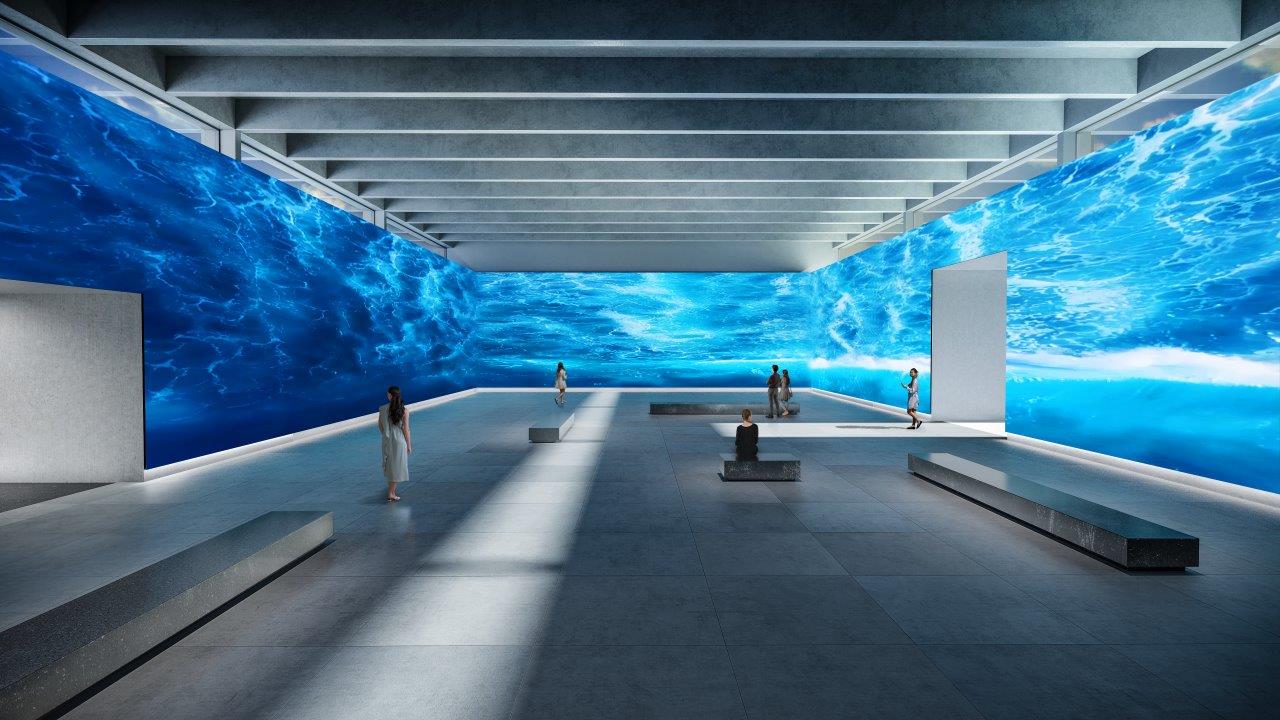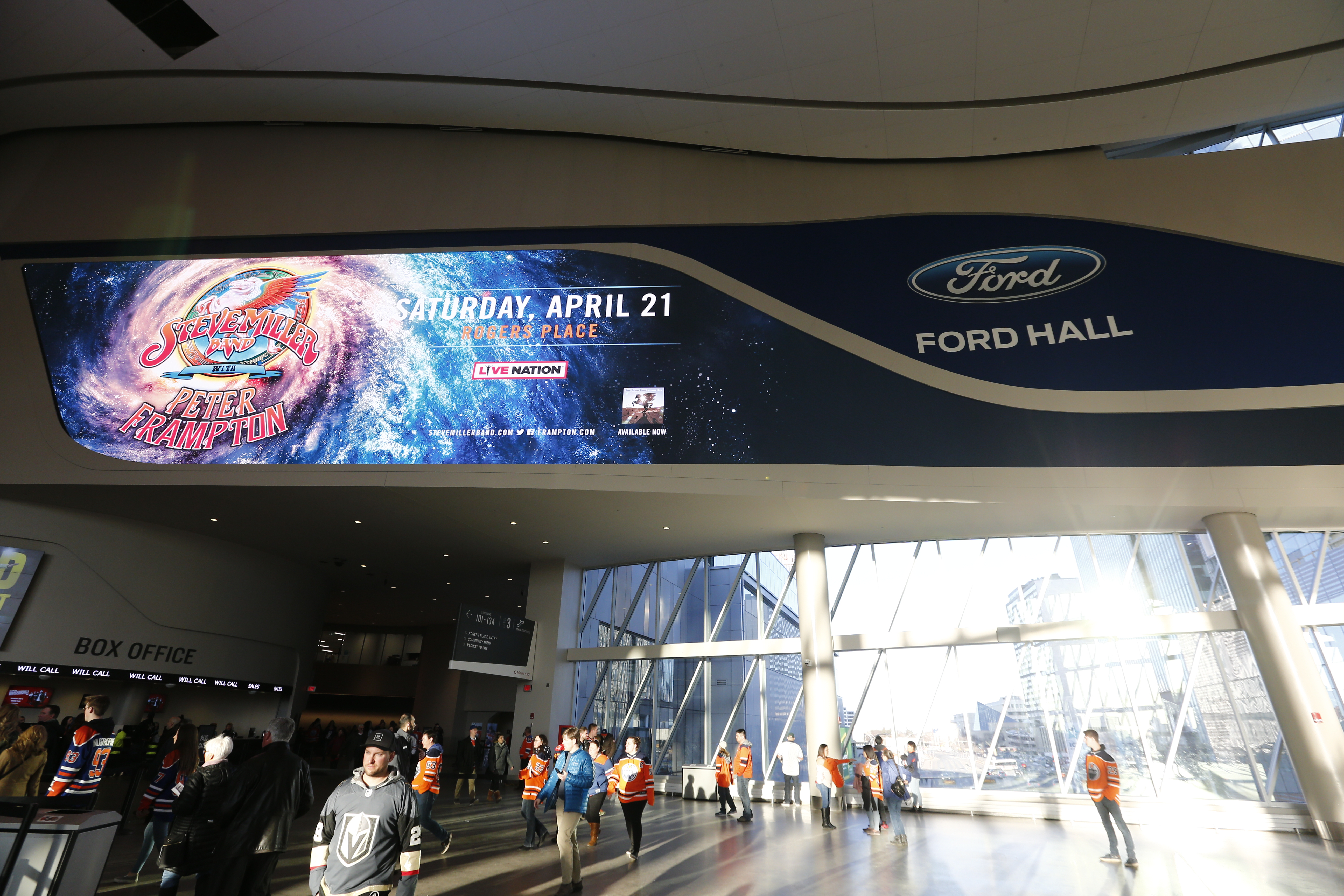Not long ago, massive video walls were mostly found on the Strip in Las Vegas, Times Square, stadiums, and control rooms. Advances in technology and a lower cost of entry have dramatically changed the visual landscape, inside and out.
While many live events and in-person gatherings have been sidelined due to the pandemic, companies and organizations turn to technology integration and distribution firms such as Synnex Corp. and VWMason Technology Consultants to create digital canvases to engage with audiences—spurring some new trends in video wall usage.
Video walls that were used for promotion pre-pandemic are being repurposed to attract and engage with audiences in a different way. "Buildings and places that we wouldn't think of as having signage are now being used for art," said Marielle Crisanti, business development manager and associate consultant at VWMason. Grants are being applied to develop creative applications within the digital medium.
Especially today, end users are working to deliver next-level experiences for their customers, and LED offers the flexibility to make that happen. Sandi Stambaugh, vice president, product management at Synnex added, "Architectural digital communications and signage provide the ability to create and deliver truly immersive experiences." With advancements in LED technologies, video walls can curve, wrap corners, cover columns, take the shape of cubes and spheres, and cross the ceiling. "There truly are few limitations," Stambaugh said. "Gone are the days of only 'boxed-in' video walls."

Whether an art installation, messaging that winds throughout a lobby, or creating the illusion of fans sitting in stands, video walls are playing a starring role. When the NBA resumed its 2019-20 season at the "NBA Bubble", a hub based at Walt Disney World's ESPN Wide World of Sports Complex in Orlando, three game courts were outfitted with 17-foot-tall LED screens—wrapping three sides of the arena to display seating populated with more than 300 virtual fans.
Across the Enterprise and Campus
In some cases, the video wall is replacing the traditional projector and screen. "We are seeing video walls (both LED and LCD) being used in a variety of new ways—whether for conference room, classrooms, lecture halls, etc.," Stambaugh said. Despite the higher cost, today's installations are more often positioning LED as an optimal choice. "With the advancement in technology, simplification of the installation process, and reduction in price points, more companies can leverage the benefits of direct-view LED technology."
VWMason's Crisanti shared a similar sentiment. "I hear of more video wall deployments versus projectors in boardrooms, as well as in regular meeting spaces and conferencing rooms." Another corporate trend taking hold is "out-of-the-box LED displays that would be equivalent to a 100-inch LCD screen," she said. These easy to set up and sometimes portable, all-in-one units have made inroads over the past year, especially for meeting rooms and classrooms that need to be transformed into ad hoc conferencing and presentation rooms.
Synnex sees continued demand for video walls, but the type of projects and environments have changed due to the pandemic. "We see fewer installations for corporations and live events, and more projects in vertical market applications," Stambaugh said. "Synnex continues to work with our partners on turnkey, affordable solutions for post-pandemic solutions such as temperature monitoring of staff and customers, messaging, distancing guidelines, and more." As hybrid work, collaboration, and education requirements continue beyond the pandemic, "we see a need for solutions that provide experiences as close to real life as possible," Stambaugh said. "Larger displays and video walls will be critical for those applications."
Some companies are capitalizing on buildings sitting idle. "A lot of people are taking advantage of this time and looking at the technology, not only for messaging, but for how they can attract people to the space when they reopen," Crisanti said. The large, flexible LED format is perfectly suited to tie internal and external messaging in different spaces.
Purpose Built Video Walls
While LCD is still the lower-cost solution, the price gap has quickly narrowed. "LCD and LED typically have different use-cases, so when looking at display technology—and especially when weighing costs—it's important to focus on ROO, or return on objective," Stambaugh said. Understanding the full use case is critical to delivering the right technology for the application. "Often, the benefits of LED technology—including brightness, lifespan, and the capacity for uncommon aspect ratios and configurations—deliver the ROI that LCD cannot," she said. "However, it is important to look at it from the customer's objective to determine if those benefits justify the cost."

Crisanti agrees, "One of the things that we always push at VWMason is knowing, what is it that you're trying to accomplish—what is your vision? How are we going to accomplish that?" Especially in these times, adaptability is critical. Having the ability to automate and create data-driven messaging to targeted audiences will help measure a return on investment.
"Because of its adaptability, we're seeing a rapid emergence of the use of LED technology and micro-LED technology versus LCD," Crisanti said. "With the need to get messaging out quickly, it is a significant draw to people that haven't looked at LED before."
LED or LCD Video Walls?
No doubt, the acquisition cost of LCD video walls is less than its LED counterpart, and there will always be applications that make sense for LCD. But then there are the practical and spectacular differences that set LED video walls apart.
"LEDs should be your first look because it's going to allow you to achieve a pretty spectacular, high-resolution, clean, seamless appearance, and you're not going to see the lines between panels," said Rich Ventura, vice president of B2B for Sony Electronics' pro division. "And you're not going to have to worry about color shift as you would with LCD." Add those benefits to the fact that LED can be curved and made into different shapes—that is when the price per pixel becomes very attractive," Rich Ventura said.
Longevity is also on the side of LEDs. Even though LED and LCD panels are both using LED lights, "the biggest inherent difference is that the LEDs on an LED wall are working together to make your image," Ventura said. "With an LCD, they're shining through a piece of glass. Over time, the glass in an LCD can degrade, and it loses brightness."
Installation and maintenance also favor LEDs. Ventura points out that installing an LED video wall is more straightforward than LCD. "With LED, you're laying out the tracks of the cabinets, mounting them, and placing the pixel cards on there, and you're off and running." This makes serviceability is easy as well. "If a card goes out, you go up with a magnet, pull a pixel card off, put another one up, check it, and you're off and running." If you had to replace an LCD display, you might need to have one shipped if there's not an extra on hand, and it will take more than one person to de-install and install. "Those things become a very big factor," Ventura said.
"From an installation and setup perspective—if you're going to do a massive, spectacular wall and you want it to capture a lot of eyes, LED should be your first look, then LCD, and then projection," Ventura concluded.
